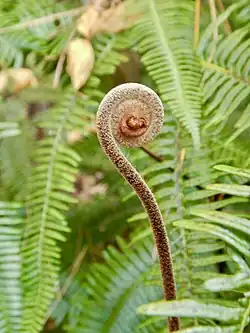薇
| ||||||||
Translingual
Han character
薇 (Kangxi radical 140, 艸+13, 19 strokes, cangjie input 廿竹人大 (THOK), four-corner 44248, composition ⿱艹微)
References
- KangXi: page 1060, character 21
- Dai Kanwa Jiten: character 32092
- Dae Jaweon: page 1524, character 9
- Hanyu Da Zidian (first edition): volume 5, page 3303, character 12
- Unihan data for U+8587
Chinese
| trad. | 薇 | |
|---|---|---|
| simp. # | 薇 | |
Glyph origin
| Old Chinese | |
|---|---|
| 矀 | *mrɯl, *mɯl |
| 覹 | *mrɯl |
| 黴 | *mrɯl, *mɯːls |
| 薇 | *mrɯl, *mɯl |
| 媺 | *mrɯlʔ |
| 微 | *mɯl |
| 溦 | *mɯl |
| 癓 | *mɯl |
| 徽 | *hmɯl |
| 幑 | *hmɯl |
Phono-semantic compound (形聲, OC *mrɯl, *mɯl) : semantic 艸 (“grass; plant”) + phonetic 微 (OC *mɯl).
Pronunciation
Definitions
薇
- Osmunda regalis, a species of fern (also known as royal fern or flowering fern)
- 陟彼南山、言采其薇。 [Pre-Classical Chinese, trad. and simp.]
- From: The Classic of Poetry, c. 11th – 7th centuries BCE, translated based on James Legge's version
- Zhì bǐ nánshān, yán cǎi qí wēi. [Pinyin]
- I ascended that hill in the south, and gathered the royal ferns.
See also
- 蕨 (jué, “bracken, eagle fern”)
Compounds
|
|
|
Japanese
Kanji
(uncommon “Hyōgai” kanji)
Readings
- Go-on: み (mi)
- Kan-on: び (bi)
- Kun: ぜんまい (zenmai, 薇)
Compounds
- 薔薇 (bara): rose
Etymology
| Kanji in this term |
|---|
| 薇 |
| ぜんまい Hyōgaiji |
| kun’yomi |
| Alternative spellings |
|---|
| 紫萁 (uncommon) 狗脊 (rare) |

Uncertain. Theories include:
- Shift from 銭舞 (zeni mai, literally “coin + twirling / spinning”), from the way the fiddleheads look like rotating or twirling coins
- Shift from 銭巻き (zeni maki, literally “coin + roll”), from the way the coil of a fiddlehead with the hole in the center looks like a traditional coin (which also has a hole in the center)[1]
- Shift from 千巻き (sen maki, literally “thousand + roll”), from the way the repeating pattern of the fiddleheads look like a lot of small things in a roll
The "roll" derivation would align with the derivation of synonym 巻子 (makago).
First attested in 1709.[2]
Pronunciation
- (Tokyo) ぜんまい [zèńmáí] (Heiban – [0])[3][4][5]
- IPA(key): [d͡zẽ̞mːa̠i]
Noun
薇 • (zenmai)
- [from 1709] Japanese flowering fern (Osmunda japonica), of which the young fiddleheads are edible
Usage notes
As with many terms that name organisms, this term is often spelled in katakana, especially in biological contexts (where katakana is customary), as ゼンマイ.
Derived terms
- 発条・撥条 (zenmai, “clockwork spring”, from the visual similarity to a coiled fern fiddlehead)
References
- 1988, 国語大辞典(新装版) (Kokugo Dai Jiten, Revised Edition) (in Japanese), Tōkyō: Shogakukan
- “薇・紫萁・狗脊”, in 日本国語大辞典 (Nihon Kokugo Daijiten, “Nihon Kokugo Daijiten”) (in Japanese), 2nd edition, Tōkyō: Shogakukan, 2000, →ISBN
- 2006, 大辞林 (Daijirin), Third Edition (in Japanese), Tōkyō: Sanseidō, →ISBN
- 1997, 新明解国語辞典 (Shin Meikai Kokugo Jiten), Fifth Edition (in Japanese), Tōkyō: Sanseidō, →ISBN
- 1998, NHK日本語発音アクセント辞典 (NHK Japanese Pronunciation Accent Dictionary) (in Japanese), Tōkyō: NHK, →ISBN
Further reading
- Entry at Nihon Jiten (in Japanese)
Korean
Etymology
From Middle Chinese 薇 (MC mˠiɪ). Recorded as Middle Korean 미 (mi) (Yale: mi) in Hunmong Jahoe (訓蒙字會 / 훈몽자회), 1527.
Hanja
Wikisource薇 (eumhun 장미 미 (jangmi mi))
薇 (eumhun 고비 미 (gobi mi))
- Hanja form? of 미 (“rose”).
- Hanja form? of 미 (“Osmunda japonica”).
Compounds
- 장미 (薔薇, jangmi)
- 장미색 (薔薇色, jangmisaek)
References
- 국제퇴계학회 대구경북지부 (國際退溪學會 大邱慶北支部) (2007). Digital Hanja Dictionary, 전자사전/電子字典.
Vietnamese
Han character
薇: Hán Nôm readings: vi
- This term needs a translation to English. Please help out and add a translation, then remove the text
{{rfdef}}.